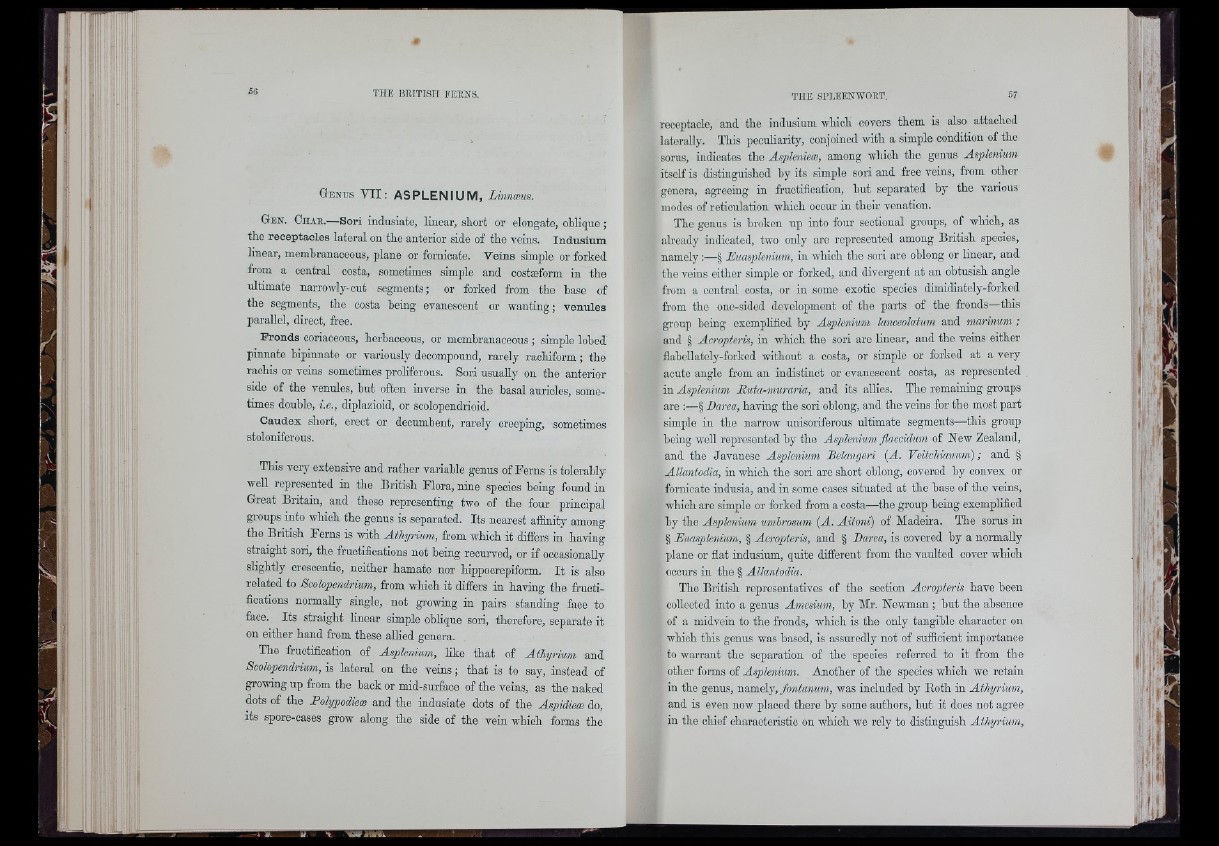
sa THE BRITISH FERNS. THE SPLEENWORT.
Genus V II: ASPLENIUM, Linnoeus.
Gen. Chak.—Sori indusiate, linear, short or elongate, oblique ;
the reeeptaeles lateral on the anterior side of the reins. Indusium
linear, membranaceous, plane or fornicate. Veins simple or forked
from a central costa, sometimes simple and costæform in the
ultimate narrowly-cut segments; or forked from the base of
the segments, the costa being evanescent or wanting; venules
parallel, direct, free.
Fronds coriaceous, herbaceous, or membranaceous ; simple lobed
pinnate bipinnate or variously decompound, rarely raohiform ; the
rachis or veins sometimes proliferous. Sori usually on the anterior
side of the venules, but often inverse in the basal auricles, sometimes
double, i.e., diplazioid, or soolopendrioid.
Caudex short, erect or decumbent, rarely creeping, sometimes
stoloniferous.
This very extensive and rather variable genus of Perns is tolerably
well represented in the British Flora, nine species being found in
Great Britain, and these representing two of the four principal
groups into which the genus is separated. Its nearest affinity among
the British Ferns is with Athyrium, from which it differs in having
straight sori, the fruotifioations not being recurved, or if occasionally
slightly crescentic, neither hamate nor hippoorepiform. It is also
related to Scolopendrium, from which it differs in having the firuoti-
fications normally single, not growing in pairs standing face to
face. Its straight linear simple oblique sori, therefore, separate it
on either hand from these allied genera.
The fruotifioation of Asplenium, like that of Athyrium and
Scolopendrium, is lateral on the veins ; that is to say, instead of
growing up from the back or mid-surface of the veins, as the naked
dots of the Polypodieoe and the indusiate dots of the Aspidieæ do,
its spore-cases grow along the side of the vein which forms the
recoptaolo, and the indusium which covers them is also attached
laterally. This peculiarity, conjoiued with a simple condition of the
sorus, indicates the Asplenieæ, among which the genus Asplenium
itself is distinguished by its simple sori and free veins, from other
genera, agreeing in fructification, but separated by the various
modes of reticulation which occur in their venation.
The genus is broken up into four sootional groups, of which, as
already indicated, two only arc represented among British species,
namely :—§ Euasplenium, in which the sori are oblong or linear, and
the veins either simple or forked, and divergent at an ohtusish angle
from a central costa, or in some exotic species dimidiately-forked
from the one-sided development of the parts of the fronds—this
group being exemplified by Asplenium lanceolatum and marinum ;
and § Acropteris, in which the sori are linear, and the veins either
flahellately-forkod without a costa, or simple or forked at a very
acute angle from an indistinct or evanescent costa, as represented
in Asplenium Buta-muraria, and its allies. The remaining groups
are :—§ Barea, having the sori oblong, and tbe veins for tbe most part
simple in the narrow unisoriferous ultimate segments—this group
being well represented by tbe Asplenium flaccidum of New Zealand,
and tbe Javanese Asplenium Belangeri (A. Veitchianum) ; and §
Allantodia, in which the sori are short oblong, covered by convex or
fornicate indusia, and in some cases situated at the base of the veins,
which are simple or forked from a costa—tbe group being exemplified
by the Asplenium umbrosum (A. Aitoni) of Madeira. The sorus in
§ Euasplenium, § Acropteris, and § Barea, is covered by a normally
plane or flat indusium, quite different from the vaulted cover which
occurs in the § Allantodia.
The British representatives of the section Acropteris have been
ooUcoted into a genus Amesium, by Mr. Newman ; but the absence
of a midvein to the fronds, which is the only tangible character on
which this genus was based, is assuredly not of sufficient importance
to warrant the separation of the species referred to it from the
other forms of Asplenium. Another of the species which we retain
in the genus, namely, fontanum, was included by Eotb in Athyrium,
and is even now placed there by some authors, but it does not agree
in the chief characteristic on which we rely to distinguish Athyrium,
iriis.
(
I il
■vl
*
Til
, {
A
■t I